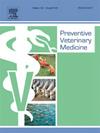Demography of owned dogs across an East African continuum of high-low human density
IF 2.2
2区 农林科学
Q1 VETERINARY SCIENCES
引用次数: 0
Abstract
Understanding the demographics of domestic dogs is essential for effective disease control strategies, particularly in areas where dogs serve as reservoirs of diseases, such as rabies. In this study, conducted in a region proximate to Nairobi, Kenya, we aimed to address the lack of current data on dog demographics. This area spans a high-to-low human density continuum, providing a unique setting for examining the relationship between human and dog populations. We used a household (HH) survey approach, stratifying the area by human population density and selecting sub-locations for every 10th percentile of the population density stratum. Households were randomly selected across strata to estimate the population of owned dogs, which was then extrapolated to the county level. Additionally, a negative binomial regression model was used to analyse the factors influencing the number of dogs owned by households. We found a human-to-owned dog ratio of 3.3:1, indicating an estimated owned dog population of 421,079 (95 % CI: 408,702–424,950) in a county with 1414,022 humans in the last census, with 65 % of the households owning a mean of 2.45 dogs. Multivariable analysis revealed that the presence of a female dog had the strongest association with owning more dogs (OR = 3.08, CI: 2.71–3.50). Wealthier households (OR = 1.67, 95 % CI: 1.12–2.49), those keeping livestock (OR = 1.67, 95 % CI: 1.36–2.02), and larger households (OR = 1.05, 95 % CI: 1.03–1.07) were significantly more likely to own more dogs. These findings suggest that actual human-dog ratios may be higher than estimated in sub-Saharan Africa. Accurate dog demographic data is important for dog-mediated disease and conditions control strategies due to its important logistical and financial implications for implementing targeted control initiatives to improve public health and animal welfare.
东非高-低人口密度连续体的养狗人口统计
了解家养狗的人口统计数据对于有效的疾病控制战略至关重要,特别是在狗作为疾病宿主(如狂犬病)的地区。在这项研究中,我们在肯尼亚内罗毕附近的一个地区进行,旨在解决目前缺乏狗人口统计数据的问题。该地区跨越了人口密度从高到低的连续体,为研究人类和狗种群之间的关系提供了独特的环境。我们采用家庭调查方法,根据人口密度对该地区进行分层,并为人口密度层的每10个百分位数选择子地点。随机选择不同阶层的家庭来估计拥有狗的数量,然后外推到县级。此外,采用负二项回归模型分析家庭养狗数量的影响因素。我们发现人与狗的比例为3.3:1,这表明在上一次人口普查中,一个拥有1414,022人的县,估计拥有的狗数量为421,079(95 % CI: 408,702-424,950),其中65 %的家庭平均拥有2.45只狗。多变量分析显示,母狗的存在与拥有更多狗的相关性最强(OR = 3.08, CI: 2.71-3.50)。较富裕的家庭(OR = 1.67, 95 % CI: 1.12-2.49)、饲养牲畜的家庭(OR = 1.67, 95 % CI: 1.36-2.02)和较大的家庭(OR = 1.05, 95 % CI: 1.03-1.07)更有可能拥有更多的狗。这些发现表明,在撒哈拉以南的非洲地区,人狗的实际比例可能比估计的要高。准确的犬类人口统计数据对于犬类介导的疾病和病症控制战略非常重要,因为它对实施有针对性的控制举措以改善公共卫生和动物福利具有重要的后勤和财政影响。
本文章由计算机程序翻译,如有差异,请以英文原文为准。
求助全文
约1分钟内获得全文
求助全文
来源期刊

Preventive veterinary medicine
农林科学-兽医学
CiteScore
5.60
自引率
7.70%
发文量
184
审稿时长
3 months
期刊介绍:
Preventive Veterinary Medicine is one of the leading international resources for scientific reports on animal health programs and preventive veterinary medicine. The journal follows the guidelines for standardizing and strengthening the reporting of biomedical research which are available from the CONSORT, MOOSE, PRISMA, REFLECT, STARD, and STROBE statements. The journal focuses on:
Epidemiology of health events relevant to domestic and wild animals;
Economic impacts of epidemic and endemic animal and zoonotic diseases;
Latest methods and approaches in veterinary epidemiology;
Disease and infection control or eradication measures;
The "One Health" concept and the relationships between veterinary medicine, human health, animal-production systems, and the environment;
Development of new techniques in surveillance systems and diagnosis;
Evaluation and control of diseases in animal populations.
 求助内容:
求助内容: 应助结果提醒方式:
应助结果提醒方式:


